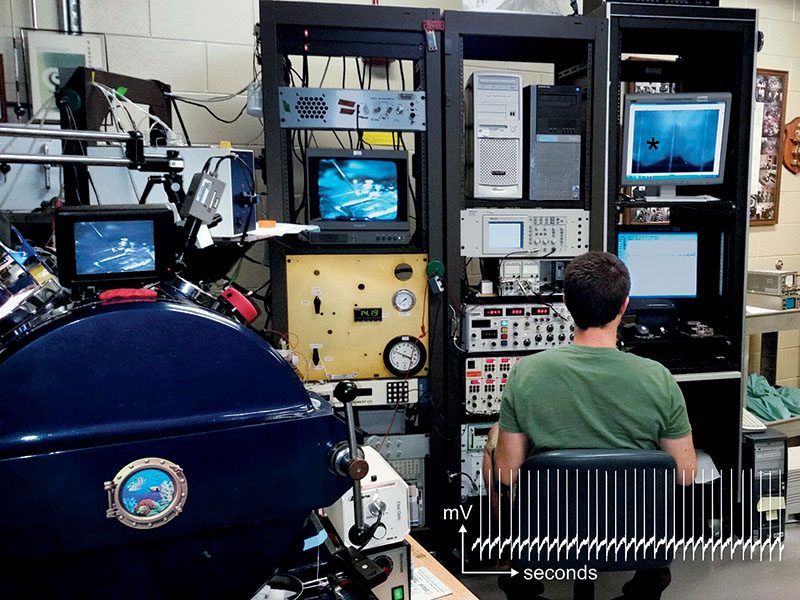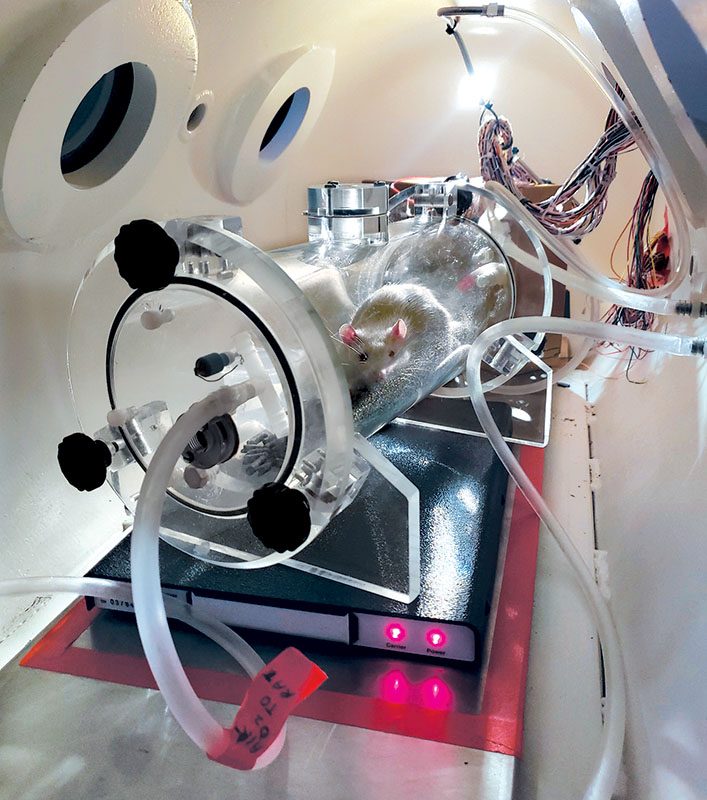Jay Dean, PhD, adalah seorang profesor farmakologi molekuler dan fisiologi di University of South Florida (USF), di mana beliau mempelajari efek oksigen, karbon dioksida, dan tekanan barometrik pada sistem saraf pusat mamalia. Penelitiannya telah meningkatkan pemahaman kita tentang kejang akibat keracunan oksigen serta tanda dan gejala peringatan sebelum kejang. Dean dan rekan-rekannya terus berupaya mencegah keracunan oksigen melalui ketosis dan pemberian suplemen.
Apa latar belakang akademis Anda?
I did my undergraduate work in biology at Central Michigan University and received my master’s degree in biological sciences at Michigan Technological University. During my master’s program, I worked on comparative respiratory control with northern water snakes, which are pugnacious 3-foot-long (90 cm) snakes that like to bite you. I studied the effects of temperature and carbon dioxide rebreathing on their ventilation and blood pH regulation.
After that, I went to Ohio State University for my doctorate to continue working in comparative respiratory control but instead ended up at a lab where I did neural-control of body temperature. That’s where I learned about the central nervous system and electrophysiology to study brain cell signaling.
Sebagai seorang postdoc, saya kembali mendalami respirasi, yang selalu menjadi minat saya. Di University of North Carolina di Chapel Hill, saya bekerja pada kemoreseptor karbon-dioksida pusat, yang memberi tahu Anda ketika Anda memiliki terlalu banyak karbon dioksida dalam sistem Anda. Akumulasi tersebut merupakan rangsangan utama Anda untuk bernapas. Saya mempelajari neuron yang peka terhadap karbon dioksida dan lokasinya di batang otak mamalia.
While doing that work, I began to think about other gases and how they affect the brain. I read about how some gases such as nitrogen don’t really affect us at sea level, but putting it in a scuba tank and diving deep enough while breathing it raises concerns about nitrogen narcosis. We also usually do fine with oxygen, but if it gets to be a high enough partial pressure, if you increase the fractional concentration (such as in nitrox), or if you go for pure oxygen, you have to worry about central nervous system oxygen toxicity.
Setelah menyelesaikan studi doktoral dan postdoc, saya mendapatkan posisi fakultas pertama saya di Wright State dan dianugerahi hibah internal yang mendanai pengembangan ruang hiperbarik pertama saya. Saya mengadaptasi alat yang saya gunakan untuk mempelajari efek karbon dioksida pada sel-sel otak untuk digunakan di bawah tekanan tinggi untuk toksisitas oksigen. Itulah cara saya memulai perjalanan saya di dunia kedokteran bawah laut. Pada tahun 2000 saya menerima dukungan finansial dari Program Kedokteran Bawah Laut Kantor Penelitian Angkatan Laut. Saya datang ke USF pada tahun 2006 dan terus bekerja untuk ONR Undersea Medicine.

Apa yang sedang Anda kerjakan saat ini?
I’m working on the mechanisms and mitigation of central nervous system oxygen toxicity and trying to find the answers to the following questions: Why does the brain suddenly develop seizures when it’s exposed to too much oxygen under pressure? Are there ways to delay it? Are there ways to predict that your level of oxygen exposure is taking you to the point where you’re going to have a seizure? Can we identify physiological markers that will warn us before seizure begins?
The problem is the tremendous variability in sensitivity to hyperbaric oxygen in terms of when seizures occur between individuals and within the same individual from day to day. We don’t quite know why that is.
We asked if a rodent’s breathing would pick up before it had a seizure. Was that possibly an early-warning physiological marker? So we did the experiments and observed that their breathing picked up anywhere from 8 to 15 minutes before a seizure. (Catatan: Komite Perawatan dan Penggunaan Hewan Institusional USF (diakreditasi oleh Asosiasi untuk Penilaian dan Akreditasi Perawatan Hewan Laboratorium Internasional) dan Biro Kedokteran Departemen Pertahanan A.S. menyetujui semua penggunaan hewan).
Since then we’ve looked at other things. We found that there’s an increase in electrodermal resistance, or skin resistance, that precedes the seizure by several minutes. The heart rate tends to slow initially during the dive, and that precedes a seizure by several minutes in an unanesthetized animal. Another marker seems to be a drop in body temperature, although the jury is still out on that. What is clear is that several of these physiologic changes precede and forewarn of impending seizures.
We’ve also successfully delayed seizures in rats by using an exogenous ketone ester developed by my colleague Dominic D’Agostino, PhD. Within 30 minutes their blood profile looked like they had been on the ketogenic diet for a week. Replacing your body’s usual primary energy source (glucose) with ketone bodies seems to have several neuroprotective effects. For example, it decreases free radical production during exposure to hyperbaric oxygen. This process delayed the seizures from 300 percent to 600 percent, creating a longer, safer dive for the rodent. The ketogenic diet will affect the brain’s oxygen consumption and utilization and do several other things that together delay onset of seizures.
Ke mana penelitian Anda membawa Anda?
Pertanyaan mendasar yang belum terjawab yang membuat kita tidak dapat menargetkan sel yang penting untuk genesis kejang adalah mengetahui dari mana kejang toksisitas oksigen berasal? Bagian otak mana yang terlibat? Penelitian menunjukkan bahwa kejang tampaknya berasal dari beberapa lokasi subkortikal di otak.
In 2019 we hypothesized that the early, abnormal cardiorespiratory changes that precede seizures suggest that so called “ox-tox trigger zones” exist in cardiorespiratory control centers of the brainstem. These ox-tox trigger zones get stimulated by a big hit of hyperbaric oxygen and begin generating their depolarizing signals. Other ox-tox trigger nuclei start to activate and then amplify and relay the signals. The activation level determines the size and complexity of the seizure. Animal models for oxygen toxicity show that the seizures are quite complex. They can range from subtle to dramatic, depending on how much the brain gets activated.
We’re currently using radiotelemetry to determine parts of brain that are activated during seizure genesis — that is, implanting a transmitter with embedded wires to measure brain activity in various regions and respiratory muscle activity. We’ve adapted the process so we can embed electrodes deep in the brain, where we think the ox-tox trigger nuclei are as well as over the motor cortex, which turns on when the seizure manifests.
Our initial studies show that these brain stem ox-tox trigger zones appear to turn on minutes to tens of minutes before we see seizure activity in the motor cortex or physical convulsions. We can study animals unrestrained, behaving freely, and unanesthetized with these implanted radio telemetry modules. It’s a powerful technique.
Menunda kejang adalah fokus lain saat ini. Kami menggunakan senyawa untuk menghambat sintesis oksida nitrat, yang bermanfaat dalam menunda kejang. Pertanyaannya adalah apakah hal tersebut dapat diterjemahkan menjadi sesuatu yang dapat disetujui oleh Badan Pengawas Obat dan Makanan AS untuk digunakan. Cawan suci adalah menemukan zat yang bekerja pada hewan dan kemudian dapat disetujui untuk digunakan pada manusia.
Mengapa melakukan penelitian fisiologis pada tikus dan bukan pada manusia?
Animal research is critical. Everything we know in medicine — including undersea medicine — starts with animal research, particularly with mammals. I’ve always been interested in fundamental questions, plenty of which we could initially answer in animals but not humans. There’s not a lot of basic research in the undersea medical community, and our goal is to have our work translated into larger animals and human divers. Animal research serves an important role in that chain of events, and I’ve been contented to do that for my career.


What do you like to do when you’re not in the lab?
Hobi utama saya adalah mempelajari sejarah kedokteran penerbangan selama Perang Dunia II. Saya memberi tahu orang-orang bahwa saya bekerja di kedalaman di bawah tekanan hiperbarik dan oksigen tinggi di siang hari, dan kemudian saya naik ke ketinggian di malam hari dan mempelajari hipoksia, dekompresi, dan ketinggian.
Fred Hitchcock was a big-time physiologist who ran the aviation medicine lab at Ohio State University during World War II and studied explosive decompression at high altitude. He had just died when I began graduate school at Ohio State. After I passed my comprehensive qualifying exams, I moved into what turned out to be Fred Hitchcock’s office as an emeritus professor. He had no family, so all his stuff was still there. One day I opened a closet to find a huge box filled with films, slides, negatives, and other documents. Later, my first faculty position was at Wright State, which is next door to WPAFB and I started spending Fridays in the archives going through declassified USAAF Aero Medical Lab reports.
Kisah menarik terkait penyelaman dari Perang Dunia II yang saya temukan adalah perkembangan penggunaan peralatan oksigen penerbangan untuk menyelam dalam keadaan darurat di laut. Para penerbang Amerika tenggelam sebelum mereka dapat dengan aman melarikan diri dari pesawat yang dibuang di laut selama perang. Laboratorium Medis Aero Angkatan Udara Angkatan Darat AS di Wright Field menguji untuk melihat apakah pilot dapat menggunakan masker oksigen penerbangan dan botol oksigen berjalan sebagai peralatan scuba untuk memungkinkan evakuasi yang aman dari pesawat yang tenggelam, dan itu berhasil!
Saya akhirnya mulai berkeliling negara untuk berbicara tentang kedokteran penerbangan. Komunitas medis kedirgantaraan sangat antusias dengan perspektif sejarah. Saya baru saja memberikan ceramah di Reno, Nevada, pada pertemuan gabungan Asosiasi Medis Dirgantara dan Masyarakat Medis Bawah Air dan Hiperbarik. Saya menjadi bagian dari diskusi panel tentang menaklukkan lingkungan penghalang tekanan, dan saya berbicara tentang penelitian yang dilakukan selama Perang Dunia II.
There’s a lot of overlap in the people who worked in undersea medicine and who continue to work in high-altitude research and vice-versa.
© Penyelam Siaga - Q1 2023